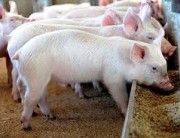The agrochemical and biotechnology firm, Monsanto, has released a few comments on the landmark Carman et al study. Their comments and answers to those critiques follow:
Author: GMO Judy Carman Website Editors
Monsanto (M): Some of the factors reported as different between the test and control groups appear to be in the normal range of observation for both.
Answer Summary: Monsanto provide no proof for this statement. Carman et al used adequate sample sizes, appropriate statistical tests and generated reliable findings.
Detailed Answer: Monsanto do not back up their assertion with any data. That is, they do not provide an officially-endorsed normal range for uterus weights for pigs, nor do they provide an officially-endorsed normal level of stomach inflammation in pigs. In fact, they provide no data at all.
It is important to understand that Monsanto are saying that the level of severe stomach inflammation seen in pigs fed the GM diet is normal in piggeries – ie that it normal for a third of pigs to experience severe stomach inflammation in piggeries. This is a worrying animal welfare allegation about conditions in commercial piggeries and Monsanto needs to provide proof for their allegations.
It is also important to understand that the level of severe stomach inflammation in the GM-fed pigs was many times higher than in the non-GM fed pigs. Overall, GM-fed pigs had 2.6 times the level of stomach inflammation, with female pigs experiencing 2.2 times the rate and male pigs experiencing 4 times the rate. This is not “normal”.
M: The author”s speculation about differing uterine weights might be the result of pigs in estrus (heat) which would be complicated by the use of a pen design that had only 1 or 2 pens per treatment.
Answer Summary: Randomisation and proximate housing ensured estrus was not a confounding factor.
Detailed Answer: Two to six pens were actually used per dietary group, depending on the age of the pigs, not 1 or 2 as Monsanto says.
The weights of the uterus cannot be due to differing rates of estrus (heat) in the pigs, as pigs were thoroughly randomised before they began their diets. And then all the pens were placed very close to each other, so that pigs could touch snouts between pens. So, if estrus in one pig stimulated estrus in another pig in this study, then all the pigs in both dietary groups should have been in estrus together. Which means that estrus cannot be causing the differences that were seen between the GM-fed and the non-GM-fed groups.
By Monsanto suggesting that the rate of estrus was different between the GM-fed and non-GM-fed pigs, then becasue of the way the study was conducted, with everything except for the GM aspect of the diet “randomised out” from having an effect on the results, then Monsanto is actually suggesting that the GM diet caused a difference in the rates of estrus in pigs. This is a hypothesis that is both interesting and worrying for health and should be followed-up.
M: The results are due to poor animal husbandry practices, as shown by the fact that pigs died, even in the control group.
Answer Summary: The pigs in both groups were treated equally, humanely and within commercial piggery standards. Any assumption otherwise would be contesting the standards of the U.S. government and should be directed as a complaint to U.S. legislators.
Detailed answer: Pigs were housed under conditions that apply in commercial piggeries in the US. If Monsanto is suggesting that these pigs were subjected to inhumanely poor conditions, then they are also suggesting more widely that pigs in commercial piggeries in the US are subjected to those conditions as well. Pigs in commercial piggeries are housed in groups. They can and do get infectious diseases and there are indeed a number of infectious diseases that tend to occur in US commercial piggeries. Furthermore, pigs fight, bite and harass each other. As a result, some pigs, particularly runts, can, and do, die. Piggery owners expect some pigs to die and they factor this into their financial returns. Indeed, if no pigs had died in this study, many US piggery owners would have found the results of the study rather incredible.
The number of pigs that died was essentially the same between the GM-fed and non-GM-fed pigs. All pigs that died underwent autopsies. In all cases, death was found to be due to things such as infectious diseases, ie things that were piggery-related. At no time did any pig handler or veterinarian note, or autopsy indicate, that there was anything treatment-related associated with any pig”s death, including intestinal or stomach problems. Moreover, the number of deaths were the same between groups, which adds weight to the evidence that there was no treatment-related aspect to these deaths.
All pigs, regardless of dietary group, were fed and treated the same way by experienced pig handlers that were blinded as to the dietary group of the pig so that any differences between the two dietary groups can only reasonably be due to the effect of the GM component of the diet.






















Please keep up the good work!!!!! We need intelligent reasoning persons like you in the fight to keep GMOs out of our world.
Thank you so much for your solid research and hard work. It seems no matter how valid the research of non-industry, non-biotech funded research, the pro-GMO shills are constantly hard at work to discredit independent research on the risks associated with GMO technology. We ‘non-scientist’ types have a difficult time arguing our case against the moles and trolls who spout Monsanto’s BS science as if it were the gospel truth. Keep up the good work! Those of us who eat are counting on you!
Good, solid work. Thank you–we so badly need persons like you doing this important work.
Thank you!
Congratulations on your ground breaking research. Keep up the good work!
Thank you for doing this important work.
Fantastic responses to this criticism. Thank you for conducting this important research!
LIKE!
Thank you, we need your serious arguments against the marketing bravado.
They just want the cream off the farmers! It should be declared on the weigh ill where the animals have grazed and what they are fed!
Monsanto has a lot to answer for!
Thank You for doing this. I have been saying for over 12 years that GMO foods are POISON. It seemed for a long time no one was listening & everyone thought I was the crazy one. LOL NOW? Hurray!!! MORE people are aware & thanks to people like you more people are learning just how truly bad it is!!!
Thank you for this research and the logical responses to initial Monsanto criticisms.
Please continue with the great work , I in the meantime will continue to make friends and family aware of the health risks in consuming meat products from animals fed on GM feed.
Well done Judy.
Man is getting too smart for it’s own good. We are doing things to nature that is un-natural. Just because we can create GMO plants in a lab doesn’t mean that we should. In all likelihood, the world should ban and prohibit all GMO plant varieties due to just cross-contamination of non-GMO plants, much less for all of the issues raised by GMOs existence. GMOs once released into the fields are uncontrollable, yet the US Government refuses to hold GMO creators and growers accountable for the contamination of non-GMO plants and fields. A corrupt system if ever I heard one.
Good luck USA in trying to eat healthy given the corruption in your own Government..!!
A study well conducted and well presented.
Time for a re-evaluation of GMO safety and move to organics.
(Even though i personally dont eat meat..).
The UNIVERSITY OF IOWA!